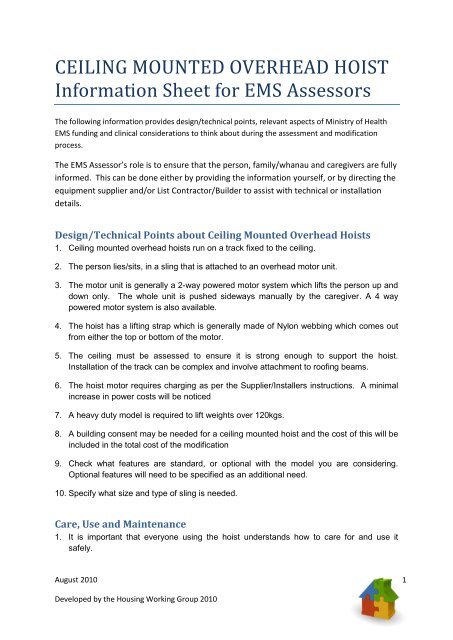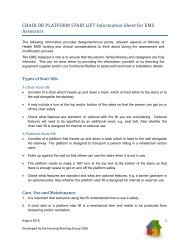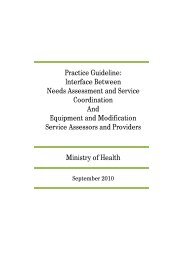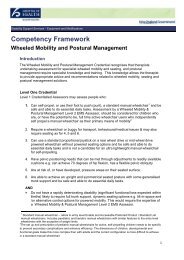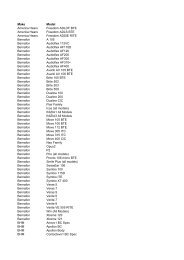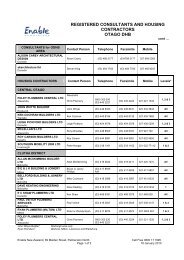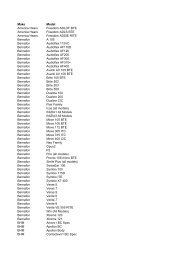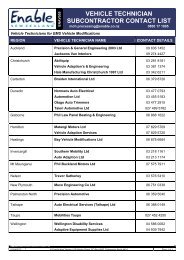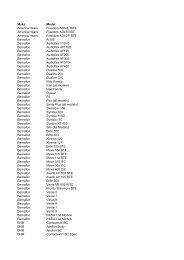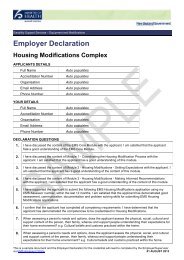Ceiling Mounted Overhead Hoists - Disability Funding
Ceiling Mounted Overhead Hoists - Disability Funding
Ceiling Mounted Overhead Hoists - Disability Funding
You also want an ePaper? Increase the reach of your titles
YUMPU automatically turns print PDFs into web optimized ePapers that Google loves.
CEILING MOUNTED OVERHEAD HOIST<br />
Information Sheet for EMS Assessors<br />
The following information provides design/technical points, relevant aspects of Ministry of Health<br />
EMS funding and clinical considerations to think about during the assessment and modification<br />
process.<br />
The EMS Assessor’s role is to ensure that the person, family/whanau and caregivers are fully<br />
informed. This can be done either by providing the information yourself, or by directing the<br />
equipment supplier and/or List Contractor/Builder to assist with technical or installation<br />
details.<br />
Design/Technical Points about <strong>Ceiling</strong> <strong>Mounted</strong> <strong>Overhead</strong> <strong>Hoists</strong><br />
1. <strong>Ceiling</strong> mounted overhead hoists run on a track fixed to the ceiling.<br />
2. The person lies/sits, in a sling that is attached to an overhead motor unit.<br />
3. The motor unit is generally a 2-way powered motor system which lifts the person up and<br />
down only. The whole unit is pushed sideways manually by the caregiver. A 4 way<br />
powered motor system is also available.<br />
4. The hoist has a lifting strap which is generally made of Nylon webbing which comes out<br />
from either the top or bottom of the motor.<br />
5. The ceiling must be assessed to ensure it is strong enough to support the hoist.<br />
Installation of the track can be complex and involve attachment to roofing beams.<br />
6. The hoist motor requires charging as per the Supplier/Installers instructions. A minimal<br />
increase in power costs will be noticed<br />
7. A heavy duty model is required to lift weights over 120kgs.<br />
8. A building consent may be needed for a ceiling mounted hoist and the cost of this will be<br />
included in the total cost of the modification<br />
9. Check what features are standard, or optional with the model you are considering.<br />
Optional features will need to be specified as an additional need.<br />
10. Specify what size and type of sling is needed.<br />
Care, Use and Maintenance<br />
1. It is important that everyone using the hoist understands how to care for and use it<br />
safely.<br />
August 2010<br />
1<br />
Developed by the Housing Working Group 2010
2. Day to day care, maintenance and charging of the hoist is the person’s responsibility.<br />
3. The overhead hoist is a mechanical item and needs to be protected from tampering<br />
and/or vandalism.<br />
4. Check with the EMS Provider about ownership. Where the overhead hoist becomes the<br />
home owner’s property. All repairs, maintenance, servicing, replacement or removal of<br />
the hoist and slings becomes the responsibility of the home owner.<br />
5. Annual maintenance for the hoist will need to be arranged by the person and/or home<br />
owner. A checklist and maintenance schedule will be supplied by the hoist installer and<br />
you need to ensure that the person knows about this and understands it must be carried<br />
out to ensure the hoist remains safe for use.<br />
When Considering Installing an <strong>Overhead</strong> <strong>Ceiling</strong> <strong>Mounted</strong> Hoist think<br />
about:<br />
1. All features of the overhead hoist required. Check with the Hoist Supplier about all the<br />
specifications of the hoist to ensure that you can establish a match between the needs of<br />
the person and the features of the hoist and slings required. The Hoist Supplier will<br />
provide you with detailed plans and costs, which will enable you to compare options.<br />
2. Note: Some factors can affect the lifting capacity of the hoist motor, and you will need to<br />
talk to the supplier about the model you are considering. Such as:<br />
The weight of the person<br />
The number of lifts required<br />
The number of fine ‘readjustment’ movements are required<br />
3. The location of the unit for charging, talk about this with the person and hoist<br />
supplier/installer.<br />
4. If the hoist is to be used over a bath the lifting strap may get wet and introduce moisture<br />
into the motor if it runs back inside the motor unit. Talk about this with the person and<br />
hoist supplier to determine the best option.<br />
Ministry of Health EMS <strong>Funding</strong> Considerations<br />
1. <strong>Funding</strong> is only available once for the same type of modification, therefore the<br />
modification recommended needs to meet the person’s needs now and in the long term.<br />
2. <strong>Ceiling</strong> mounted overhead hoists are attached to the home and considered a housing<br />
modification. They do not often meet EMS funding criteria as there are generally more<br />
cost effective alternatives that should be considered first such as using equipment:<br />
portable wheeled hoist<br />
August 2010<br />
2<br />
Developed by the Housing Working Group 2010
portable overhead hoist (i.e. not fixed to the ceiling)<br />
3. A portable overhead hoist may be a more suitable option if the need is not long term or<br />
the home is rented<br />
4. Generally the track is installed in:<br />
the bedroom for transfers from bed to wheelchair or shower commode or<br />
in the bathroom over the shower/bath/toilet.<br />
5. Be careful when considering a track system is more extensive:<br />
going from room to room, or<br />
with turntables or<br />
complicated designs or<br />
a room covering track ( H-track) or<br />
a four-way motor (powered up/down and side to side).<br />
Note: These do not often meet EMS funding criteria as there are generally<br />
more cost effective alternatives. You will need to talk with the EMS Provider<br />
about why these options are essential.<br />
6. It is helpful to understand the difference between a housing modification vs. equipment<br />
vs. equipment included in a housing modification vs. housing equipment:<br />
A housing modification is a permanent / fixed alteration to the home. The housing<br />
modification becomes the home owner’s property.<br />
Equipment which is portable (able to be easily picked up and moved) and is not fixed<br />
to the home (and is applied for via an Equipment Application) and is owned by the<br />
Ministry of Health.<br />
Equipment included in a housing modification is an item that is fixed to the home.<br />
Housing equipment is equipment that is included in a housing modification that is<br />
removable and able to be refurbished for reissue to another person. The use of<br />
reissue housing equipment provides considerable savings to the Ministry of Health<br />
EMS budget.<br />
Note: Generally housing equipment includes: 1m low rise platform lifts and<br />
modular ramps. The EMS Provider identifies if the equipment included in the<br />
housing modification application is considered as ‘housing equipment’ and will<br />
remain the property of the Ministry of Health or becomes the property of the<br />
home owner. Check with the EMS Provider for equipment such as stair chair<br />
lifts, stair platform lifts, 1.5m lifts, multi-floor lifts, ceiling track hoists, bidets,<br />
shower beds etc.<br />
August 2010<br />
3<br />
Developed by the Housing Working Group 2010


